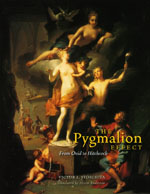
Victor I. Stoichita, The Pygmalion Effect: From Ovid to Hitchcock (Translated by Alison Anderson), Chicago: The University of Chicago Press, coll. "The Louise Smith Bross Lectures", 2008. viii, 252 pages ; 12 p. of plates.
- ISBN 9780226775210
- $45.00
Recension par David Cast (Bryn Mawr College) dans Bryn Mawr Classical Review 2009.04.20.
Extraits en ligne sur amazon.com.
Présentation de l'éditeur:
Between life and the art that imitates it is a vague, more shadowycategory: images that exist autonomously. Pygmalion's mythicalsculpture, which magnanimous gods endowed with life after he fell inlove with it, marks perhaps the first such instance in Western arthistory of an image that exists on its own terms, rather than simplyimitating something (or someone) else. In The Pygmalion Effect,Victor I. Stoichita delivers this living image—as well as its manyavatars over the centuries—from the long shadow cast by art that merelyreplicates reality. Stoichita traces the reverberationsof Ovid's founding myth from ancient times through the advent ofcinema. Emphasizing its erotic origins, he locates echoes of thisfamous fable in everything from legendary incarnations of Helen of Troyto surrealist painting to photographs of both sculpture and peopleartfully posed to simulate statues. But it was only with the inventionof moving pictures, Stoichita argues, that the modern age found afitting embodiment of the Pygmalion story's influence. Concluding withan analysis of Alfred Hitchcock films that focuses on Kim Novak'sdouble persona in Vertigo, The Pygmalion Effectilluminates the fluctuating connections that link aesthetics, magic,and technical skill. In the process, it sheds new light on a mysteriousworld of living artifacts that, until now, has occupied a dark andlittle-understood realm in the history of Western image making.
Victor I. Stoichita is professor of modern and contemporary art history at the University of Fribourg, Switzerland. His many books include Goya: The Last Carnival and A Short History of the Shadow.
Table des matières:
Acknowledgments
Introduction
1. Modifications
Bones and Flesh Caresses Blush
2. Amplifications
The Arrow Living Stone Songs, Tubas, and Cymbals
3. Variations
Joys and Sorrows of an Artist's Model Vive Figure
4. Doubles
Helen and the Eidolon Helen and the Statue
The Talking Statue in the “Gallery” of the Cavalier Marino
“Like an old tale”
5. The Nervous Statue
The Step
The Sculpture in Painting/The Sculpture in Sculpture Knots
“An ethereal fluid / Into the softened stone has already penetrated”
6. Photography/Sculpture
The End of the Sitting (Photography and Sculpture)
The Rise of the “Very lifelike ghost” (Photosculpture)
7. The Original Copy
The Pygmalionian Relationship
Madeleine's Chignon
Judy's Face
The Transformation
In Guise of a Conclusion
Appendix: Ovid, Metamorphoses, 10.238–97
Notes
List of Illustrations
Index